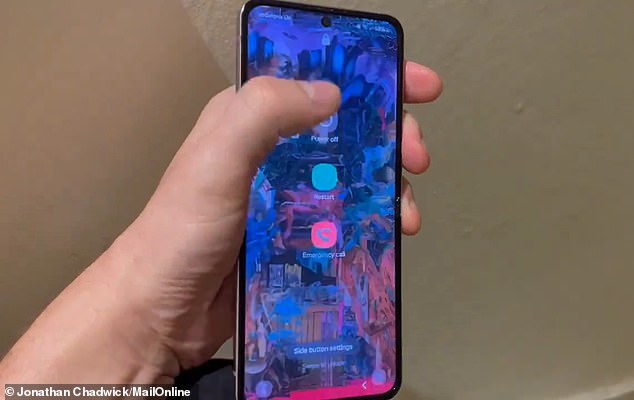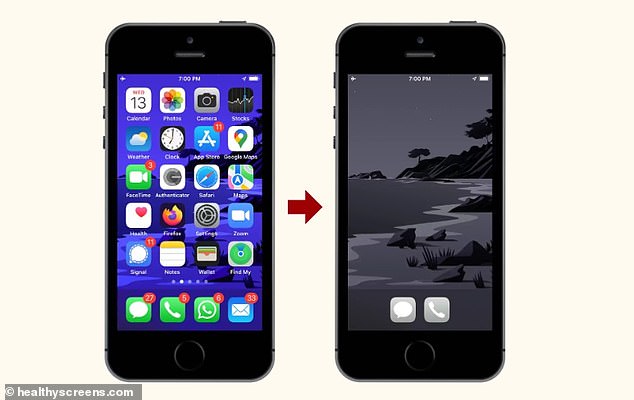Carol Vorderman Claims An Unusual Phone Habit Helped Her Avoid Burnout – Now Science Says She’s Right
If you’re struggling with the demands of a modern digital lifestyle, the solution may just come from an unlikely source.
TV presenter Carol Vorderman, 63, has revealed she turns off her smartphone for 12 hours a day to help her avoid ‘burnout’ after a health crisis.
Turning off the device allows her mind to disconnect from professional obligations because she “can no longer work seven days a week.”
Speaking at the Cheltenham Literature Festival, she said: ‘I now switch my phone off for 12 hours a day. Like physically disabled. Usually during the night hours.
“But it’s pretty good, you know that when you just have it next to your bed and you just reach out your hand.” Let me check… Ahh, two hours later.”
Does this ‘half and half’ method – 12 hours on and 12 hours off per day – really improve well-being?
MailOnline’s Jonathan Chadwick not only tried the method himself, but also spoke to psychologists and smartphone addiction experts to find out.
TV presenter Carol Vorderman has revealed she switches off her smartphone for 12 hours a day to help her avoid ‘burnout’ after a health crisis
‘Burnout’ is not recognized by the World Health Organization (WHO) as a medical condition, but as a ‘syndrome’: a collection of health signs or symptoms.
It is a state of physical, mental and emotional exhaustion that can occur when you experience prolonged stress and feel under constant pressure.
It is thought that smartphone use can cause burnout by exposing people to life’s excessive demands, such as work or parental responsibilities.
Dr. Jay Olson, a postdoctoral researcher at McGill University’s Department of Psychology in Canada, said no research has been done on Vorderman’s specific approach.
It appears that Vorderman himself came up with the half-and-half method, although it is unclear whether it is yet popular with the public.
However, despite the lack of scientific research so far, Dr. Olson said he thinks it could actually work.
‘Reducing smartphone use can indeed help with burnout,’ Dr Olson told MailOnline.
“If you can stick with the 12-hour schedule, it can be helpful, but if it’s something you try for a week and then stop, it will probably have little effect in the long run.”
Vorderman said her device tends to be turned off at night, rather than during the day, such as from 6 p.m. to 6 a.m.
While this doesn’t address the problem of excessive smartphone use during the day, it does at least provide a realistic starting point for reducing screen time.
According to Dr. Olson, turning it off at night will also help break the habit of starting and ending the day by checking the phone.
“I suggest you set the 12-hour period so that you avoid the phone for a few hours before bed and a few hours in the morning,” he said.
In addition, it is said to reduce light exposure from the phone screen in the evening, which is associated with the inability to fall asleep.
Dr. Olson led a study that identified 10 solutions to reduce screen time, including switching to “grayscale” and turning off facial recognition.
MailOnline’s verdict
As a full-time commuter and parent of two children, I admit that I sometimes suffer from burnout symptoms, as listed by charity Mental Health UKincluding exhaustion, feeling overwhelmed and ‘persistent feelings of anxiety’.

At 7pm I turn off my Samsung Flip phone for 12 hours – although turning off a phone is a lot more labor intensive than I remember!
I also feel like I’m spending more time on my smartphone than ever, so I decided to try the half-and-half method for myself.
I turn off my Samsung Flip phone from 7pm to 7am, which means I don’t have to sit on the couch scrolling through Instagram Reels after the kids are asleep, or check news and social media on the morning train.
I don’t turn off my phone very often at all. In fact, when I do, it takes me a while to figure out exactly how to do it.
Samsung doesn’t make it easy either: I have to simultaneously press and hold the side key and the bottom half of the volume rocker for two seconds before tapping ‘power off’ and then finally entering my PIN!
Once the device is finally turned off, I stash it under my bed and try to forget about it – but it’s funny how often my subconscious doesn’t let me.
During the evening I notice that reaching for my smartphone has become an innate habit, as natural and instinctive as scratching an itch.
The trigger is usually when something random flashes through my mind and I want to search Google for information, like Thomas Tuchel’s management history or the location of the Orbit brewery whose beer I drink.
But does my temporary admission reduce ‘burnout’?

Dr. Olson led a study that identified 10 solutions to reduce screen time, including switching to ‘scale of gray’ (pictured)
When I walk into work the next morning, my mind definitely feels a lot clearer and fresher, although this could also be due to other factors such as a good night’s sleep.
Admittedly, I don’t turn my phone back on until a few minutes after 7am – certainly a sign that I’m a full-fledged smartphone addict who’s been desperately waiting for his next hit.
However, I would like to continue this experiment longer to see the longer-term physical and emotional benefits.
Dr. Heather Shaw, a psychology lecturer at Lancaster University, warned that there can be both positive and negative effects of these types of ‘digital detoxes’.
People “don’t experience phone withdrawal symptoms” in the same way someone would when detoxing from substances, she said, challenging the idea that technology use is an addiction.
“Carol Vorderman has found a way to use technology that suits her,” Dr Shaw told MailOnline.
‘But we should not always regard technology use as harmful.’
